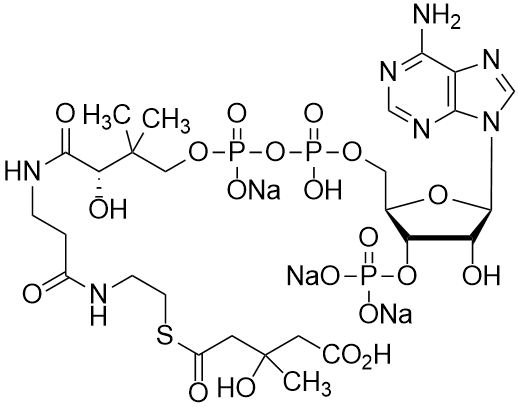DL-3-Hydroxy-3-methylglutaryl coenzyme A sodium salt hydrate is widely utilized in research focused on:
- Cholesterol Management: This compound is a key ingredient in statin medications, which help lower cholesterol levels, making it vital for cardiovascular health.
- Biochemical Research: It serves as a substrate in enzymatic reactions, aiding researchers in studying metabolic pathways and enzyme functions.
- Pharmaceutical Development: Used in the formulation of drugs targeting metabolic disorders, it plays a crucial role in developing effective treatments.
- Food Industry: Its application in dietary supplements supports health claims related to cholesterol reduction, appealing to health-conscious consumers.
- Animal Health: This compound is also used in veterinary medicine to manage cholesterol levels in animals, ensuring their overall health and wellbeing.
General Information
Properties
Safety and Regulations
Applications
DL-3-Hydroxy-3-methylglutaryl coenzyme A sodium salt hydrate is widely utilized in research focused on:
- Cholesterol Management: This compound is a key ingredient in statin medications, which help lower cholesterol levels, making it vital for cardiovascular health.
- Biochemical Research: It serves as a substrate in enzymatic reactions, aiding researchers in studying metabolic pathways and enzyme functions.
- Pharmaceutical Development: Used in the formulation of drugs targeting metabolic disorders, it plays a crucial role in developing effective treatments.
- Food Industry: Its application in dietary supplements supports health claims related to cholesterol reduction, appealing to health-conscious consumers.
- Animal Health: This compound is also used in veterinary medicine to manage cholesterol levels in animals, ensuring their overall health and wellbeing.
Documents
Safety Data Sheets (SDS)
The SDS provides comprehensive safety information on handling, storage, and disposal of the product.
Product Specification (PS)
The PS provides a comprehensive breakdown of the product’s properties, including chemical composition, physical state, purity, and storage requirements. It also details acceptable quality ranges and the product's intended applications.
Certificates of Analysis (COA)
Search for Certificates of Analysis (COA) by entering the products Lot Number. Lot and Batch Numbers can be found on a product’s label following the words ‘Lot’ or ‘Batch’.
*Catalog Number
*Lot Number
Certificates Of Origin (COO)
This COO confirms the country where the product was manufactured, and also details the materials and components used in it and whether it is derived from natural, synthetic, or other specific sources. This certificate may be required for customs, trade, and regulatory compliance.
*Catalog Number
*Lot Number
Safety Data Sheets (SDS)
The SDS provides comprehensive safety information on handling, storage, and disposal of the product.
DownloadProduct Specification (PS)
The PS provides a comprehensive breakdown of the product’s properties, including chemical composition, physical state, purity, and storage requirements. It also details acceptable quality ranges and the product's intended applications.
DownloadCertificates of Analysis (COA)
Search for Certificates of Analysis (COA) by entering the products Lot Number. Lot and Batch Numbers can be found on a product’s label following the words ‘Lot’ or ‘Batch’.
*Catalog Number
*Lot Number
Certificates Of Origin (COO)
This COO confirms the country where the product was manufactured, and also details the materials and components used in it and whether it is derived from natural, synthetic, or other specific sources. This certificate may be required for customs, trade, and regulatory compliance.


